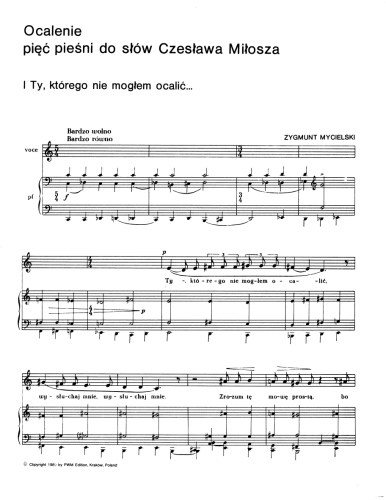![Ocalenie [Rescue] for mezzo-soprano or baritone with piano to words by Czesław Miłosz (1946-1948)](/upload/thumb/2022/11/mycielski_ocalenie_nuty_skan_005_auto_800x900.jpg)
Ocalenie [Rescue] for mezzo-soprano or baritone with piano to words by Czesław Miłosz (1946-1948)
dedications (depending on manuscript version): to Stanisław Kołodziejczyk on the ninth All Souls’ Day since Rysio’s death, En hommage à Mademoiselle Nadia Boulanger – Zygmunt Mycielski
duration: ca 10’
edition: PWM 1989
premiere: Kraków, 27 October 1946, ??? (songs I, II, III, V); Wiśniowa, 22 October 1990, Piotr Szpara – baritone, Dariusz Noras – piano (complete cycle)
Questions about the essence of art and its non-artistic functions in the face of the dramatic events of the twentieth century can be referred to a unique artistic dialogue in which Czesław Miłosz and Zygmunt Mycielski engaged between 1945 and 1948, considering the functions of poetry with regard to the crisis of and threat to culture after the Second World War. The poem “Foreword”, which caused quite a stir among poets in the first half of the twentieth century, opens Miłosz’s collection of poetry entitled Ocalenie [Rescue] published in 1945. It was the first post-war volume of Miłosz’s poems and at the same time the last one published in Poland before his dramatic decision, taken in 1951, to stay as an émigré in France. In defining his position with regard to high culture, Miłosz formulated a poetic programme, as it were, pointing among its most important assumptions to the simplicity of the message, referential nature of the langue and the belief in the impact of art, which could help to r e s c u e the surrounding reality, the belief in the ethical potential of poetry.
The size and nature of the songs from the cycle prompted Zofia Helman to describe these vocal miniatures as a five-part song (Zofia Helman, [analytical commentary in] Zygmunt Mycielski, Ocalenie, PWM, Kraków 1989, p. 17).
The songs are put together on the basis of the principle of contrast. Factors that create a different mood in every segment of Ocalenie are the tempo, rhythm, type of expression, texture and type of accompaniment. Elements which are common to all songs and which determine the cohesion of the work are dissonant chords of major and minor sevenths and ninths, small melodic motifs recurring in the various miniatures, intimacy, focus achieved by means of a chamber line-up as well as an extraordinary type of expression.
Undertaking to interpret a work of such importance to Polish poetry of the second half of the twentieth century, a work in which Czesław Miłosz asks questions – of key significance from the artistic perspective – about the condition and sense of the existence of art after the drama of the Second World War, Zygmunt Mycielski harmonises the flow of the musical narrative with the expression of the poetic word. He makes the musical form of the songs dependent entirely on the structure of the poetic text, generally not interfering with the structure of the poem and introducing only some repetitions. The composer does not refer to key words and phrases again and again, but, in a way, complements the mood of the text with music. In order to highlight important moments in the poetry, he resorts to rests, intervallic leaps, dynamic and textural contrasts, emphasising in the climactic fragment (Song IV) the solo voice against piano chords. As if the most important questions no longer required a musical complement... As if the composer, like Miłosz, faced the question about the ethical dimension of art and decided not to provide an answer...
